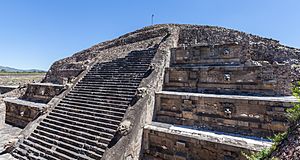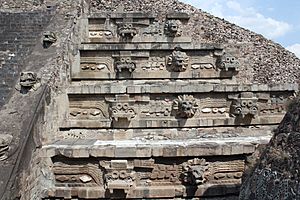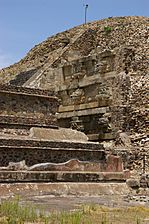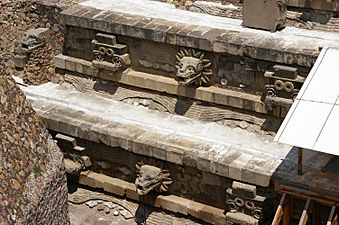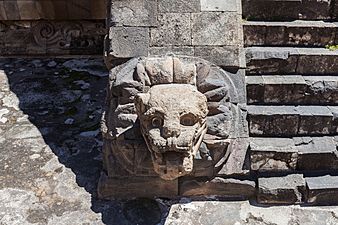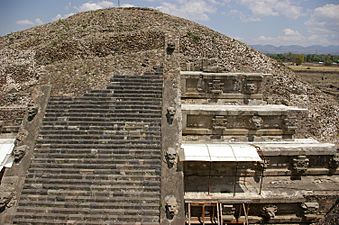Temple of the Feathered Serpent, Teotihuacan facts for kids
The Temple of the Feathered Serpent is a huge pyramid in central Mexico. It's the third largest pyramid at Teotihuacán, an ancient city built long before Christopher Columbus arrived. The name "Teotihuacan" also refers to the people and culture of this amazing place.
This pyramid is famous for a special reason. In the 1980s, archaeologists found over a hundred buried people beneath it. These burials, like the pyramid itself, are from around 150 to 200 CE. The pyramid gets its name from carvings of a "feathered serpent" god on its sides. These are some of the oldest pictures of this god. Later, the Aztecs called a similar god Quetzalcoatl. Today, people also call it the Temple of Quetzalcoatl or the Feathered Serpent Pyramid.
Contents
Where is the Feathered Serpent Temple?
The Temple of the Feathered Serpent is at the end of the Avenue of the Dead. This was the main street in Teotihuacan. The temple sits inside a large area called the Ciudadela complex.
The Ciudadela means "citadel" or "fortress" in Spanish. It has tall walls and a huge open space. This courtyard was so big it could hold all the grown-ups of Teotihuacan! At its busiest, the city had about 100,000 people. Inside the Ciudadela, there are other big buildings. These include two large houses near the temple. There's also a platform called the Adosada. This platform was built later, around the 4th century. It stands right in front of the temple, partly blocking the view.
What Does the Pyramid Look Like?
The Feathered Serpent Pyramid is a step pyramid with six levels. It's built in a special style called talud-tablero. This means it has sloping walls (talud) and flat panels (tablero).
The edges of each level are decorated with carved heads. These are feathered serpent heads mixed with heads of another snake-like creature. Many think this other creature is Tlaloc, the rain god. But some experts believe they might be "war serpents" or "fire serpents." These figures have a spot for shiny obsidian glass in their eyes. When the sun hit them, their eyes would have sparkled!
Long ago, the whole pyramid was painted. The background was blue, and carved seashells added more decoration. Below the rows of heads, there are carvings of the full feathered serpent. These carvings show the serpent from the side. They also have symbols for water. All these designs were more than just pretty. They had a deep meaning for the people of Teotihuacan. Some think they tell a story about how the world began. Others see symbols of leaders or war.
Today, the Adosada platform hides much of the pyramid. This might show a big change in Teotihuacan's leaders around the 4th century CE. Maybe it meant people wanted a different kind of leadership. In the early 1900s, part of the pyramid's front was found. It has amazing carvings of the feathered serpent and other gods. You can also see seashells on panels next to a staircase.
Keeping the Pyramid Safe
This ancient pyramid has been outside for a very long time. Rain, water from the ground, and even tiny plants have caused damage. The stone surface has worn away. Too many tourists visiting also made the damage worse.
In 2004, the Temple of Quetzalcoatl was put on a list of endangered monuments. The World Monuments Fund helped to protect it. They worked with the Instituto Nacional de Antropología e Historia (Mexico's national history institute) and American Express.
Burials at the Pyramid
Archaeologists found over 200 burials at the pyramid. They believe these people were sacrificed when the temple was built. The burials are in different spots, and we don't fully understand why.
Both men and women were buried there, but more men were found. The men were buried with weapons and necklaces made of human teeth. This makes experts think they were warriors. They were likely warriors who served Teotihuacan, not prisoners from other groups. The closer the burials were to the pyramid's center, the richer the items buried with them.
Amazing Discoveries Beneath the Temple
In 2003, something amazing happened. Archaeologists Sergio Gómez Chávez and Julie Gazzola accidentally found a tunnel under the Temple of the Feathered Serpent! After heavy rain, Gómez Chávez saw a small sinkhole near the pyramid.
He was lowered into the dark hole. He found a perfectly round shaft that led to an ancient, man-made tunnel. It was blocked by huge stones. Gómez knew about another tunnel under the Pyramid of the Sun. He thought this might be a similar secret passage. He decided to plan a careful exploration. He put a tent over the sinkhole to protect it from tourists. Researchers believe the tunnel was sealed around 200 CE.
Planning and getting money for the dig took over six years. In 2004, Dr. Victor Manuel Velasco Herrera used ground-penetrating radar to map the tunnel. This helped them figure out how long it was and if there were rooms inside.
In 2009, the government gave Gómez permission to dig. By the end of 2009, archaeologists found the real entrance to the tunnel. It led to underground rooms where ancient rulers might have been buried. In 2010, Gómez Chávez announced they would enter the tunnel. This was the deepest excavation ever at Teotihuacan.
The tunnel runs under the Feathered Serpent Temple. The real entrance was sealed with large rocks almost 2,000 years ago. The sinkhole from 2003 was not the actual entrance. A deep shaft, about 5 meters wide, leads down 14 meters to the tunnel. The tunnel itself is nearly 100 meters long. It ends in several underground rooms carved into the rock.
Workers carefully removed almost 1,000 tons of soil. They found many amazing objects:
- Large seashells
- Jaguar bones
- Pottery
- Pieces of human skin
- Wooden masks with jade and quartz
- Fancy necklaces and rings
- Greenstone crocodile teeth and human figures
- Crystals shaped like eyes
- Beetle wings in a box
- Jaguar sculptures
- Hundreds of shiny, round balls
These mysterious balls were found in two rooms. They were 40 to 130 millimeters wide. They had a clay center covered with a yellow material called jarosite. This material forms when pyrite (a shiny mineral) breaks down. George Cowgill, an expert, said, "Originally the spheres would have shone brilliantly." All these items were placed there on purpose, like offerings to the gods.
At the end of the tunnel, there's a room that looks like the underworld. It's about 17 meters under the pyramid's center. A tiny mountain landscape was built to hold objects. This included a rubber ball (used in the Mesoamerican ball game) that stood for the Sun. Small pools of liquid mercury looked like lakes.
They also found four greenstone statues. They wore clothes and beads, and their open eyes would have sparkled with precious minerals. Two statues were still in their original spots, looking up. They might be the first spiritual leaders of Teotihuacan. They seem to guide visitors to the sacred place. They carried bundles of sacred items, like mirrors made of pyrite. These mirrors were thought to be doorways to other worlds.
The tunnel walls and ceiling were covered with a special mineral powder. It was made of magnetite, pyrite, and hematite. This made the tunnel glow, like standing under the stars. It was a special way to show the underworld.
As each part of the tunnel was cleared, a 3D scanner recorded the progress. By 2015, nearly 75,000 pieces of artifacts had been found and studied. These amazing discoveries were shown in a big exhibit in San Francisco in 2017.
How the Pyramid Connects to the Calendar
The Temple of the Feathered Serpent seems to be connected to the ancient calendar. The pyramid is thought to have 260 feathered serpent heads on its platforms. Each head has an open space in its mouth. This space is big enough to put a marker in.
People in Teotihuacan might have moved this marker around the pyramid. This would show the days of their special calendar. When an important spiritual day arrived, people would gather inside the Ciudadela walls to celebrate.
Political Changes at the Temple
The Temple of the Feathered Serpent was not just a religious place. It was also a political center. The leaders of Teotihuacan were not only in charge of the people. They were also the city's spiritual guides. The two large houses near the pyramid might have belonged to powerful families.
An interesting thing about the Feathered Serpent Pyramid is that it shows a change in power or beliefs in Teotihuacan. The Adosada platform was built much later than the pyramid. It stands right in front of the pyramid, blocking its view. This suggests that the political leaders or the ideas connected to the Feathered Serpent Pyramid lost their importance. So, the pyramid was partly covered up by the Adosada.
In 378, a group from Teotihuacan caused a big change in Tikal, Guatemala. This wasn't the whole Teotihuacan state. It was a group of the Feathered-Serpent people, who had been forced out of their city. The Feathered-Serpent Pyramid was burned, all the sculptures were pulled from the temple, and another platform was built to cover the front...
Gallery
See also
 In Spanish: Pirámide de la Serpiente Emplumada para niños
In Spanish: Pirámide de la Serpiente Emplumada para niños


